Elena Kagan Speaks, Promises To Serve Her Lizard Overlords

And kill all the white people! Actually, no. She mostly just praised Justice Stevens, and said that Supreme Court Justices should be impartial! And said that the Supreme Court should serve the American people! God. Some day we’ll have a Supreme Court Justice who isn’t totally boresville.
Asbury Park Ponders Making Men And Women A Little More Equal, A Lot Less Sweaty

“Women in other parts of the world go to the beach topless. We think New Jersey women are just as beautiful as any women anywhere in the world.”
That’s Asbury Park, N.J., deputy mayor John Loffredo, as quoted by this Daily News story about his jurisdiction maybe allowing women who are soaking up the sun’s rays on the local beaches to bare their breasts, just like their Vitamin D-starved counterparts across the Hudson can. The city council will vote on the matter next week. As always, the comments are quite the hoot, with someone by the name of “kitty62862” saying, “Well, ladies, if you’re flapping them in the breeze, don’t cry when someone decides to cop a feel.” Because obviously men who go shirtless in public places (like section 521 of Citi Field, which yesterday was apparently deemed by someone a shirt-optional zone) complain about getting their nipples pinched by passerby all the time, right?
Bill Clinton: Let's Blow Up That Oil Spill!
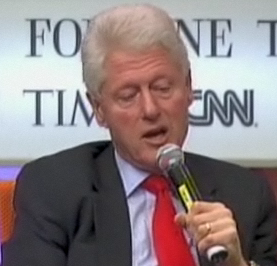
You know who sucks? James Cameron. He didn’t stop the Gulf Oil Spill. Kevin Costner and his “Ocean Therapy Solutions”? Screw that dude. And Brad Pitt hasn’t even started to try, but you know he’s thinking about it, so to hell with him too. So now Bill Clinton says we’re gonna have to blow that shit up. Celebrities! We’re just at their mercy to fix our environmental disasters. Also watch how inane Wolf Blitzer is as he talks to old Bill about FEELING PEOPLE’S PAIN. You know what? Maybe each generation gets the environmental disaster that it deserves. They certainly get the media coverage of it that they deserve.
Toronto Goes Insane, Racks Up Largest Mass Arrests in Canadian History
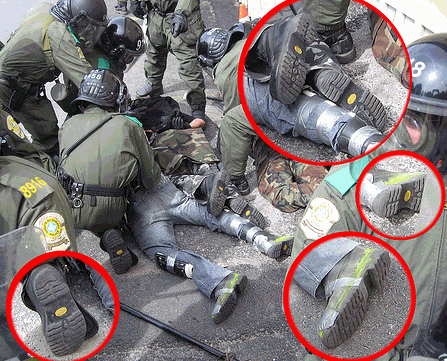
The arrests in Toronto have been, shall we say, sweeping. Given the history in Canada of police officers working undercover as instigating protesters, lots of folks were skeptical about some of the sources of the property violence at the G20 protests this weekend in Toronto. Like, why are some of the protesters and police, as these folks point out, all wearing the same brand of boots? I know Canada is a terrible poor country with very few choices in footwear, but, really? Of course, lots of the sign- and window-smashing contingent are clearly people who believe in going out and smashing things. But here’s the ultimate in protester failure.
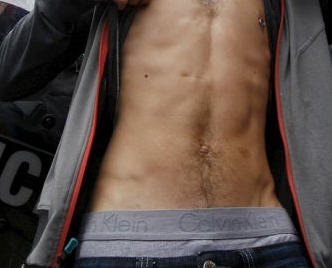
Yup. Calvin Klein! Smash the multinational imperialist branding corporation state… just not in your pants. I feel safe in calling this protester the king of the hypocrite morons.
But more seriously! The mayor of Toronto has been busy on his Twitter, repeating things like “these people cannot be true Torontonians…” Right. Well, we’ll see what he’s saying when the city, having gone totally Giuliani-style, has to settle millions of dollars worth of lawsuits to actual Torontonians over the indiscriminate arrests.
This also seems worth noting:
Spokeswoman Catherine Martin of Integrated Security Unit would not offer any details on why police appeared to allow violent protesters to smash windows and burn police cruisers on Saturday, yet quickly cracked down on apparently peaceful protests held on Sunday. She said it “depended on what circumstances were being faced.”
"Airplane!" At 30
The skyborne-disaster comedy Airplane! turns 30 years old next month, and Matt Zoller Seitz’s look back on the flick and its influences way down the lines of comedy is quite a good read. (The revelation that the movie is partially responsible for the movie career of the not-funny-just-sorta-gross Farrelly brothers isn’t going to dim my enthusiasm for it!)
Freakshow: Two Humans Can Stand Each Other for 62 Years
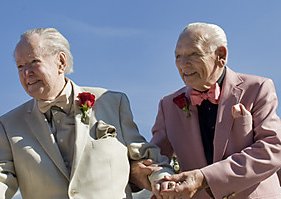
The Washington Post carries this disturbing story of human oddity: two people, who met 62 years ago and have been together ever since, wed last week. Insanity! Why, take any normal human, and you’ll see how crazy that is-that’s more three times longer than all four of Rush Limbaugh’s marriages combined! In fact, that’s longer than his four marriages plus the length of all three of Rudy Giuliani’s marriages! Gross!
The Quarter-Pound Hot Dog: What It Means For Us

Maura Johnston: “The new and improved Footlong Quarter Pound Coney is a blend of beef and pork and boasts a bigger size than ever before, weighing in at a quarter pound, while still featuring the classic coney toppings of chili and cheese.”
Jess Harvell: I’m eating here.
Maura: But wait — what do hot dogs usually weigh?
Jess: This sounds like the setup to a dirty joke.
Maura: Hahahahaha.
Maura: And the answer is… Two ounces!
Jess: So it’s like… four hot dogs? I’m confused.
Maura: I think just two. Which is sort of what a footlong is anyway!
Maura: Boo to Sonic for making their new product seem more impressive than it actually is!
Jess: Well, people have been doing that with wieners for centuries.
Some Day We'll All Shut Up About Robyn But Not Today
I know how insanely annoying it is when everyone likes something and won’t shut up and you’re like, “Wait, what? Am I supposed to like this? I don’t know if it’s for me? What are you all blathering about?” So, if you’re tired of everyone going on and on about Robyn, that’s understandable. But let the man explain it to you from the beginning: “Robyn’s new album, ‘Body Talk Pt. 1,’ provides eight handsomely formed, near-perfect pop songs that are embedded with a casual kind of feminism.” Yes, and me, I like it because it’s easy to imagine that Prince secretly wrote all the songs.
Headlines Are Made of Popular Words
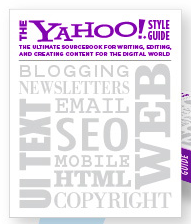
Yahoo! has published a style guide. “It’s Strunk and White for the online world,” said Arianna Huffington. They really do explain how the web works! For example, they explain how people make headlines.
There are some things to know, first: “if you’re writing a serious story about a natural disaster, the headline should not be frivolous.” That is true; we have all gone wrong there! Then it goes a little something like this:
If you have done keyword research for your page, you already know the words to target. Otherwise, ask yourself which words you would use in a search to find this story. Proper nouns-the names of people, places, and things-are good. Avoid abbreviations, because people tend to spell out words in searches. Then use those five or six keywords in a short sentence, which you will later trim to headline length.
Example
Your keywords
Fab-U-Loz Chocolate, baby boomers, heart attack prevention, longevity
Draft sentence
Study finds Fab-U-Loz Chocolate prevents heart attacks in baby boomers.
Now you can have a website too!
The Big Levi's Lie Campaign
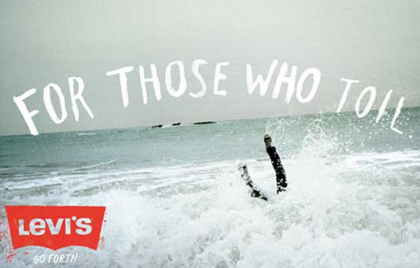
No one wants to hear about the dreary plight of working, let alone nonworking, Americans in our grand consumer republic. The whole subject is a colossal downer-and as a recent Pew poll shows, Americans are, despite all evidence to the contrary, strung out on uplift. They believe that in the near future, we will have cured cancer, sloughed off our fossil fuel dependency, created a race of talking computers, and even-oh, what the hell-revived extinct animal species. Sure, there will also be nuclear terrorist attacks and another world war-but that, of course, is just the price of admission for the return of Jesus, an event that 41% of respondents say is right on schedule for mid-century.
However, hard-luck communities needn’t despair of being entirely left out of this riot of meliorism. For it turns out that if they’re just matched with the right distressed consumer brand, distressed Americans are ideal marketing mascots. That’s the clear lesson of Stuart Elliott’s recent ad-industry dispatch for the New York Times, laying out the strategic alliance of Braddock, PA, and Levi-Strauss and Co.
Braddock was in steep industrial decline long before anyone knew what a mortgage-backed derivative might be. The town was the site of Andrew Carnegie’s first steel mill, completed in 1873-and Carnegie’s maiden institutional experiment with robber-baron guilt appeasement, his first endowed civic library, as well. But Braddock’s population peaked at 20,000 in 1950. Now, it’s down to just under 3,000 souls, and its genuinely resourceful and well-meaning mayor, John Fetterman, has been trying to woo frontier-spirited real-estate shoppers to move to the town. He’s converted the husk of a long-gone downtown furniture store into a free artists’ studio space. He’s converted an abandoned Presbyterian Church into a community center-and financed its recent expansion with funds from his 401(k). He’s also persuaded an alternative energy company to set up shop in a downtown warehouse, where it joins the still-working Carnegie Mill as one of the town’s only major employers.
So it’s certainly hard to fault Fetterman for seizing on a $1 million offer from Levi-Strauss to serve as the spiritual mascot of the jean manufacturer’s “Go Forth” campaign. The company launched that initiative in 2009 as a come-on to the dungaree world’s prized 18-to-34 demographic-and its first ads initially struck an odd neo-Tea Party note. As another Times ad piece explained last year, the campaign bought copious print space around the Fourth of July, where the text ran “alongside or near reprints of the Declaration of Independence.” The text proper echoed “the style of help-wanted classifieds in seeking ‘independent minds for a small writing project with long-term publishing possibilities. Must have talent for revolutionary thinking. Rabble rousing a plus.’” Adjourning to the Levi Strauss web site, curious young jean aficionados were urged, Glenn Beck-style, to compose “a New Declaration of the United States of America.”
Well, that clearly didn’t take-most patriotically themed U.S. declarations of the past year being, you know, distinctly middle-aged and more cynically unhinged than even ad professionals could have anticipated. And since ad-industry trends can readily pivot on a dime, Levi’s is repositioning itself now as a sober austerity brand, down with the struggling working folk. In the Braddock campaign-which will help fund more community-center renovations, together with an urban farming initiative-the slogans have the eerie didactic quality of high Soviet propaganda: “Ready to work,” “Everybody’s work is important,” and “We are all workers.” The campaign also uses real Braddock residents instead of professional models-all in pursuit of the hotly coveted ad currency known as “authenticity.” “We wanted to engage consumers in a conversation about real work,” explains Doug Sweeney, identified as “vice president for Levi’s brand marketing for the Americas at Levi Strauss.”
Wisely, Sweeney appears to have refrained from using his own job title as the opening conversational feint-but he also seems to have the chronic difficulty most impression-management professionals share when they have to ponder the real-world referents for the symbols they manipulate. “We’re marrying ‘Go forth’ with something very tangible,” he says-without seeming to be aware that referring to less-fortunate fellow humans as “something very tangible” isn’t a very promising conversation starter, either.
There are other problems with a brand like Levi’s getting married to a social-realist celebration of worker autonomy. In 2004, the company shuttered its last two American production facilities, joining the clothing industry’s great global race to the wage bottom. It’s true that the company did recently reach a wage accord with union workers at its North American distribution facilities. But its global operations have also been repeatedly called out for breaches of the company’s own code of corporate ethics.
A Haitian contractor for the company named Grupo M fired workers trying to organizing for wage increases and better working conditions in 2004, and then illegally refused to hire them back and reinstate their backpay. The same basic scenario played out with the manufacturer’s main Mexican contract partner, the Lajat factory, in 2006. (Both contracting trespasses were later rectified, but only after concerted pressure from union and anti-corporate activists.)
Now the company is fending off allegations that a Lesotho facility, run by a Taiwanese contractor, has been releasing effluents and untreated waste water into a nearby river, and carelessly dispatching razors and textile needles to a nearby municipal dump frequented by child ragpickers. In a Turkish contractor’s facility, meanwhile, a technique for artificially distressing Levi’s and H&M; jeans has produced an outbreak of silicosis, a disease all but vanished from the European continent. Forty-four workers in the plant have died from the condition, most of them under the age of 30, according to an investigation by the French news show Envoyé Spécial.
Such revelations lend a grim irony to a voiceover appeal in one of the Braddock-themed ads in the new Levi’s campaign: “People don’t think there are frontiers anymore. They can’t see how frontiers are all around us.” Oh, the garment industry knows how to find frontiers, all right. And the notion that techniques for artificially distressing jeans are disabling real human respiratory systems gives an especially unpleasant gloss to Sweeny’s faux-populist asseveration that “real work and real people will ultimately drive real change.”
But the visual iconography of the campaign of course doesn’t draw on footage of toxic Lesotho rivers and Turkish sweat shops. Instead, the Times reports of a new TV spot: “the commercial-to be shown on television and movie theaters-stylistically evokes two movies about the West, ‘The Searchers’ (1956) and ‘Days of Heaven’ (1978).” After all, explains Wieden and Kennedy account man Tyler Whisnand, the horny-handed co-creator of the new “Go Forth” campaign, “We didn’t want to photograph people in front of brick walls and call it work wear. We wanted to show the people really doing the work, the hard work, to rebuild after the recession”-and so much the better if “they need a good, sturdy pair of jeans or a trucker jacket to get down to work.”
I’m not sure why the campaign needed to ransack those big-sky-and-murder epics for an appropriately authentic visual style, however. After all, Braddock has already served as a location for a far more thematically apt Hollywood production-the 2009 adaptation of Cormac McCarthy’s post-apocalyptic scarcity-and-cannibalism novel, The Road. Go forth, indeed.
Chris Lehmann is at work right now.
